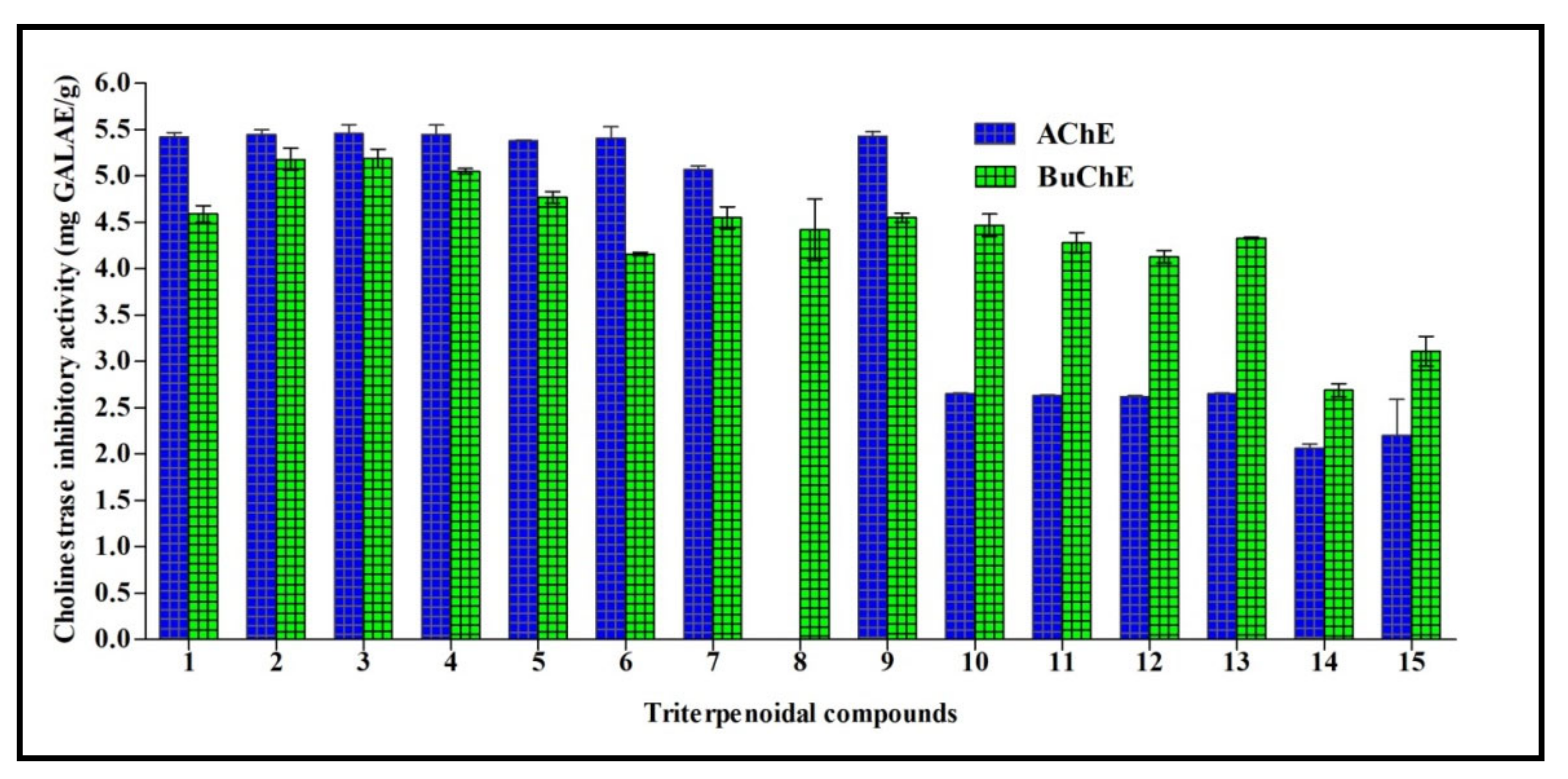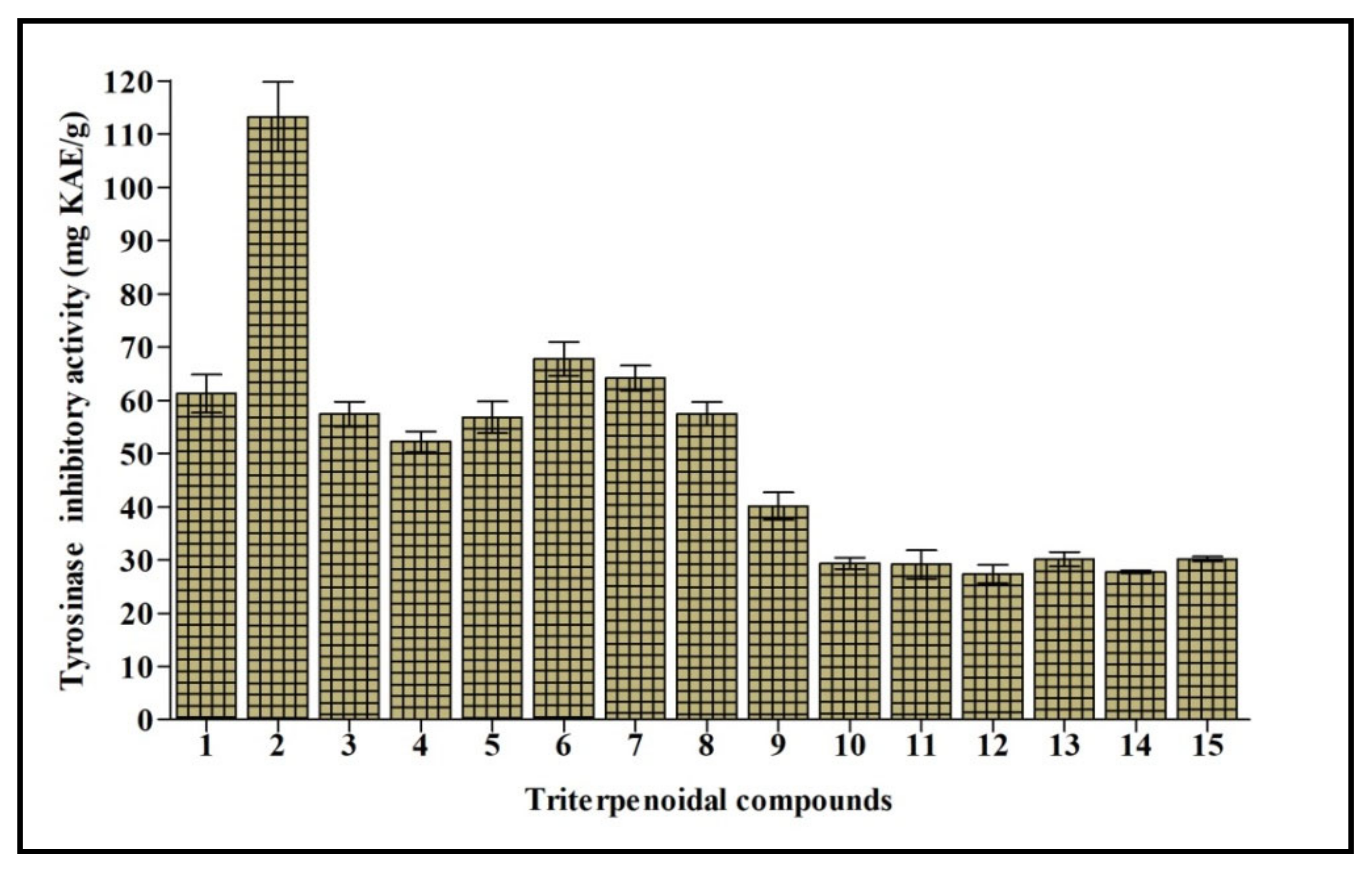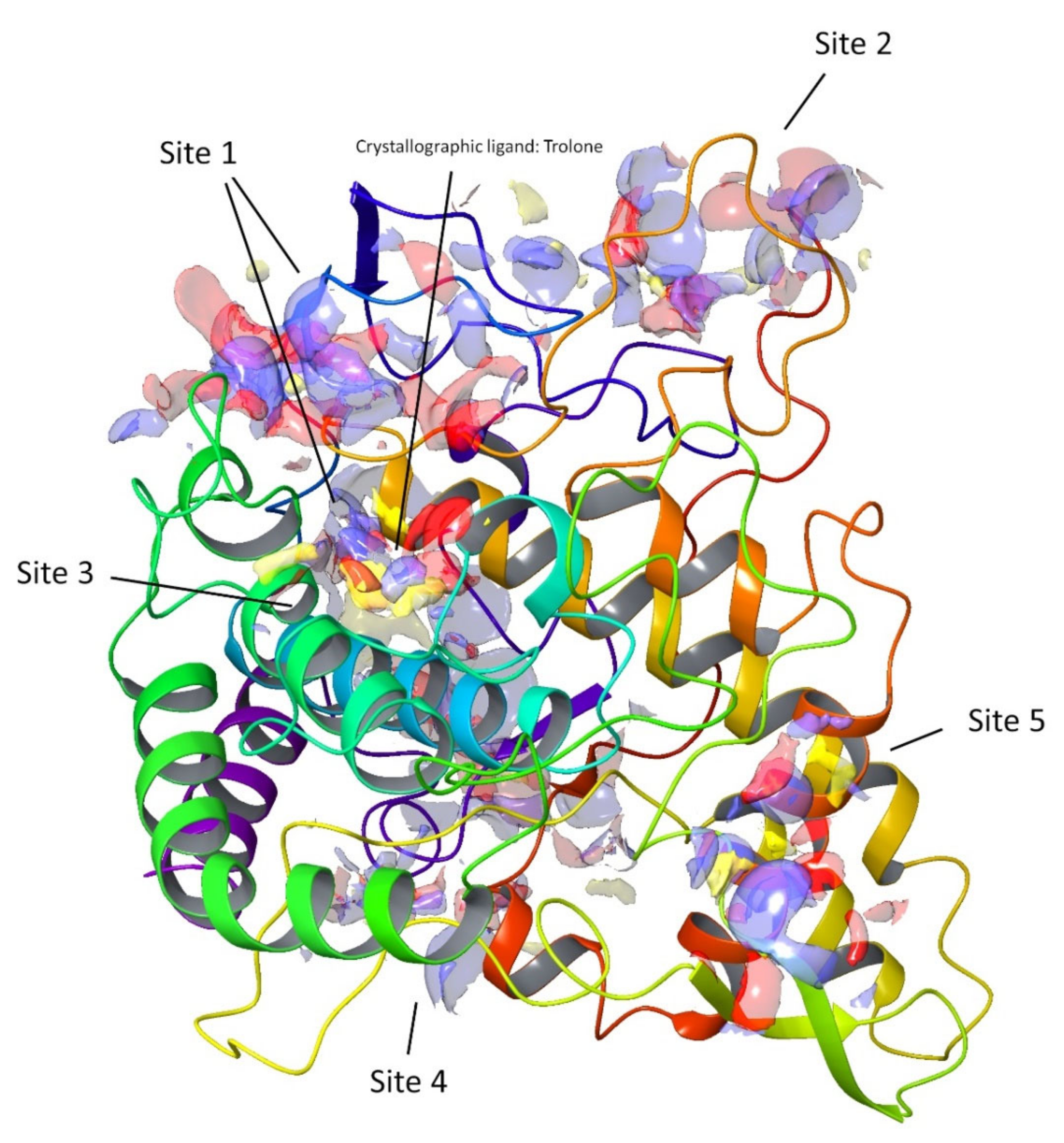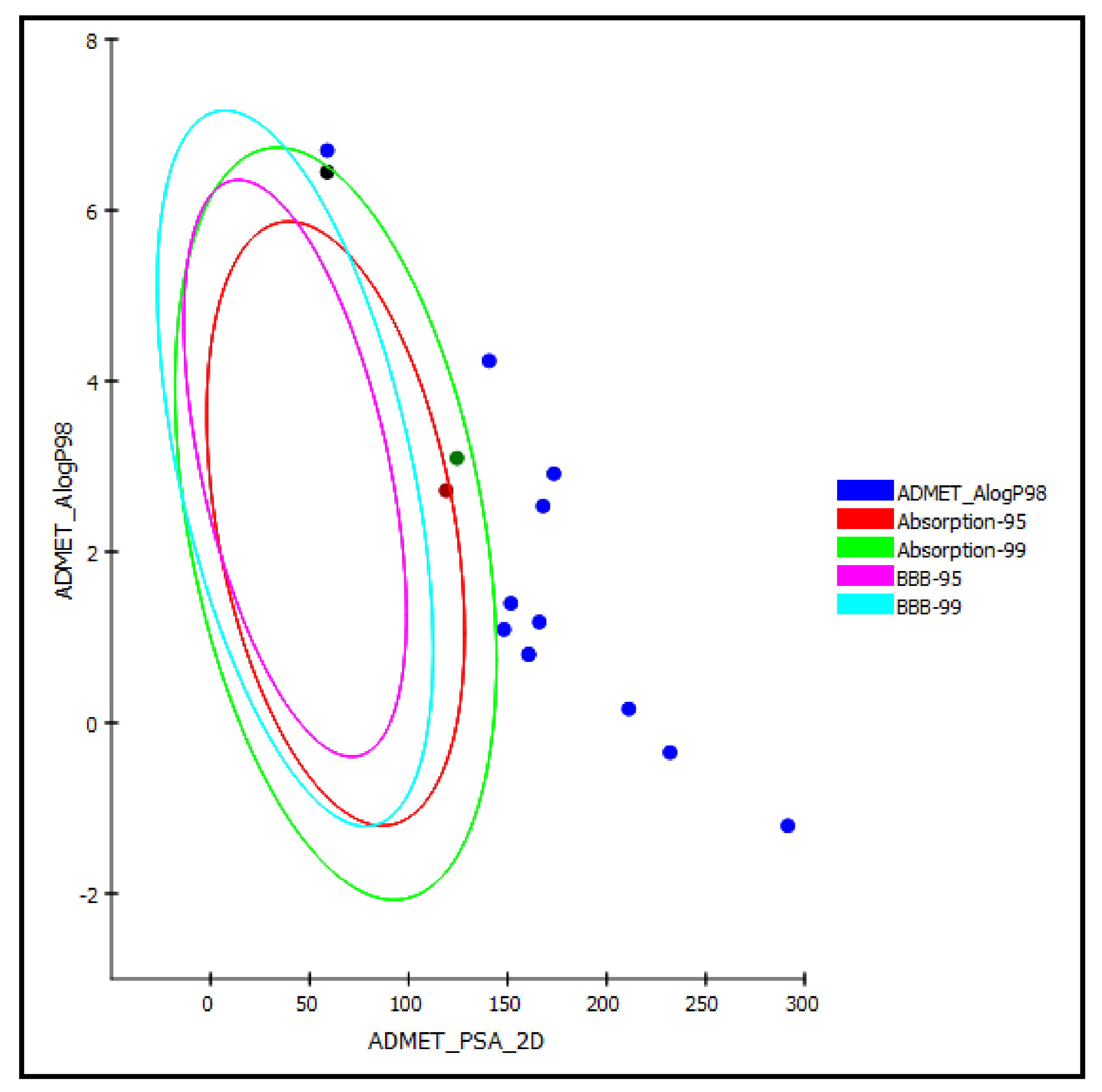Validation of the Antioxidant and Enzyme Inhibitory Potential of Selected Triterpenes Using In Vitro and In Silico Studies, and the Evaluation of Their ADMET Properties
Abstract
:1. Introduction
2. Results and Discussion
2.1. Triterpenes Used in This Study
2.2. In Vitro Assays for the Evaluation of the Antioxidant Activity of the Studied Triterpenes
2.2.1. Total Antioxidant Activity by the Phosphomolybdenum Method
2.2.2. 1,1-Diphenyl-2-Picrylhydrazyl (DPPH*) Radical Scavenging Capacity Assay
2.2.3. 2,2′-Azinobis(3-Ethylbenzothiazoline)-6-Sulfonic Acid (ABTS) Cation Radical Scavenging Activity
2.2.4. Cupric Ion-Reducing Activity (CUPRAC) Assay
2.2.5. Ferric-Reducing Antioxidant Power (FRAP) Assay
2.2.6. Metal-Chelating Activity on Ferrous Ions
2.3. In Vitro Assays for the Evaluation of the Enzyme Inhibitory Activity of the Studied Triterpenes
2.3.1. Cholinesterase (ChE) Inhibitory Activity
2.3.2. Tyrosinase Inhibitory Activity
2.3.3. α-Amylase and α-Glucosidase Inhibitory Activity
2.4. Molecular Modelling Study
2.5. ADMET/TOPKAT Prediction
3. Materials and Methods
3.1. Triterpenes Used in This Study
3.2. In Vitro Assays for the Evaluation of the Antioxidant Activity of the Studied Triterpenes
3.2.1. Total Antioxidant Activity by the Phosphomolybdenum Method
3.2.2. 1,1-Diphenyl-2-Picrylhydrazyl (DPPH*) Radical Scavenging Capacity Assay
3.2.3. 2,2′-Azinobis(3-Ethylbenzothiazoline)-6-Sulfonic Acid (ABTS) Cation Radical Scavenging Activity
3.2.4. Cupric Ion-Reducing Activity (CUPRAC) Assay
3.2.5. Ferric-Reducing Antioxidant Power (FRAP) Assay
3.2.6. Metal-Chelating Activity on Ferrous Ions
3.3. In Vitro Assays for the Evaluation of the Enzyme Inhibitory Activity of the Studied Triterpenes
3.3.1. Cholinesterase (ChE) Inhibitory Activity
3.3.2. Tyrosinase Inhibitory Activity
3.3.3. α-Amylase Inhibitory Activity
3.3.4. α-Glucosidase Inhibitory Activity
3.4. Molecular Modelling Study
3.4.1. Preparation of the Enzyme
3.4.2. Preparation of the Ligand
3.4.3. Molecular Docking Experiments
3.4.4. Molecular Mechanics Energies Combined with Generalized Born and Surface Area Continuum Solvation (MM-GBSA)
3.4.5. Site Maps
3.5. ADMET/TOPKAT Prediction
3.6. Statistical Analysis
4. Conclusions
Author Contributions
Funding
Institutional Review Board Statement
Informed Consent Statement
Data Availability Statement
Acknowledgments
Conflicts of Interest
Sample Availability
References
- Finaud, J.; Lac, G.; Filaire, E. Oxidative stress. Sports Med. 2006, 36, 327–358. [Google Scholar] [CrossRef]
- Pepe, H.; Balci, Ş.S.; Revan, S.; Akalin, P.P.; Kurtoğlu, F. Comparison of oxidative stress and antioxidant capacity before and after running exercises in both sexes. Gender. Med. 2009, 6, 587–595. [Google Scholar] [CrossRef] [PubMed]
- Lennicke, C.; Rahn, J.; Lichtenfels, R.; Wessjohann, L.A.; Seliger, B. Hydrogen peroxide–production, fate and role in redox signaling of tumor cells. Cell Commun. Signal. 2015, 13, 1–19. [Google Scholar] [CrossRef] [PubMed] [Green Version]
- Thabet, A.A.; Youssef, F.S.; El-Shazly, M.; El-Beshbishy, H.A.; Singab, A.N.B. Validation of the antihyperglycaemic and hepatoprotective activity of the flavonoid rich fraction of Brachychiton rupestris using in vivo experimental models and molecular modelling. Food Chem.Toxicol. 2018, 114, 302–310. [Google Scholar] [CrossRef]
- Petersen, R.C. Alzheimer’s disease: Progress in prediction. Lancet. Neurol. 2010, 9, 4–5. [Google Scholar] [CrossRef] [Green Version]
- Ummat, V.; Tiwari, B.K.; Jaiswal, A.K.; Condon, K.; Garcia-Vaquero, M.; O’Doherty, J.; O’Donnell, C.; Rajauria, G. Optimisation of ultrasound frequency, extraction time and solvent for the recovery of polyphenols, phlorotannins and associated antioxidant activity from brown seaweeds. Marine Drugs. 2020, 18, 250. [Google Scholar] [CrossRef]
- Li, R.; Ru, Y.; Wang, Z.; He, X.; Kong, K.-W.; Zheng, T.; Zhang, X. Phytochemical composition, antioxidant activity, and enzyme inhibitory activities (α-glucosidase, xanthine oxidase, and acetylcholinesterase) of Musella lasiocarpa. Molecules 2021, 26, 4472. [Google Scholar] [CrossRef]
- Mattioli, R.; Francioso, A.; d’Erme, M.; Trovato, M.; Mancini, P.; Piacentini, L.; Casale, A.M.; Wessjohann, L.; Gazzino, R.; Costantino, P. Anti-inflammatory activity of a polyphenolic extract from Arabidopsis thaliana in vitro and in vivo models of Alzheimer’s disease. Int. J. Mol. Sci. 2019, 20, 708. [Google Scholar] [CrossRef] [PubMed] [Green Version]
- Farag, M.A.; Sakna, S.T.; El-Fiky, N.M.; Shabana, M.M.; Wessjohann, L.A. Phytochemical, antioxidant and antidiabetic evaluation of eight Bauhinia L. species from Egypt using UHPLC–PDA–qTOF-MS and chemometrics. Phytochemistry 2015, 119, 41–50. [Google Scholar] [CrossRef] [PubMed]
- Santiago, L.A.; Mayor, A.B.R. Lupeol: An antioxidant triterpene in Ficus pseudopalma Blanco (Moraceae). Asian Paci. J. Trop. Biomed. 2014, 4, 109–118. [Google Scholar] [CrossRef] [Green Version]
- Mamadalieva, N.Z.; Youssef, F.S.; Ashour, M.L.; Sasmakov, S.A.; Tiezzi, A.; Azimova, S.S. Chemical composition, antimicrobial and antioxidant activities of the essential oils of three Uzbek Lamiaceae species. Nat. Prod. Res. 2019, 33, 2394–2397. [Google Scholar] [CrossRef]
- Aboulwafa, M.M.; Youssef, F.S.; Gad, H.A.; Altyar, A.E.; Al-Azizi, M.M.; Ashour, M.L. A comprehensive insight on the health benefits and phytoconstituents of Camellia sinensis and recent approaches for its quality control. Antioxidants 2019, 8, 455. [Google Scholar] [CrossRef] [Green Version]
- Patocka, J. Biologically active pentacyclic triterpenes and their current medicine signification. J. Appl. Biomed. 2003, 1, 7–12. [Google Scholar] [CrossRef] [Green Version]
- Hussain, H.; Ali, I.; Wang, D.; Hakkim, F.L.; Westermann, B.; Rashan, L.; Ahmed, I.; Green, I.R. Boswellic acids: Privileged structures to develop lead compounds for anticancer drug discovery. Expert Opin. Drug Dis. 2021, 16, 851–867. [Google Scholar] [CrossRef] [PubMed]
- Hussain, H.; Ali, I.; Wang, D.; Hakkim, F.L.; Westermann, B.; Ahmed, I.; Ashour, A.M.; Khan, A.; Hussain, A.; Green, I.R. Glycyrrhetinic acid: A promising scaffold for the discovery of anticancer agents. Expert Opin. Drug Dis. 2021. [CrossRef]
- Rodríguez-Díaz, M.; Delporte, C.; Cartagena, C.; Cassels, B.K.; González, P.; Silva, X.; León, F.; Wessjohann, L.A. Topical anti-inflammatory activity of quillaic acid from Quillaja saponaria Mol. and some derivatives. J. Pharm. Pharmacol. 2011, 63, 718–724. [Google Scholar]
- Farag, M.A.; Weigend, M.; Luebert, F.; Brokamp, G.; Wessjohann, L.A. Phytochemical, phylogenetic, and anti-inflammatory evaluation of 43 Urtica accessions (stinging nettle) based on UPLC–Q-TOF-MS metabolomic profiles. Phytochemistry 2013, 96, 170–183. [Google Scholar] [CrossRef]
- Aboulwafa, M.M.; Youssef, F.S.; Gad, H.A.; Sarker, S.D.; Nahar, L.; Al-Azizi, M.M.; Ashour, M.L. Authentication and discrimination of green tea samples using UV-Visible, FTIR and HPLC techniques coupled with chemometrics analysis. J. Pharm. Biomed. Anal. 2018, 164, 653–658. [Google Scholar] [CrossRef] [PubMed]
- Zengin, G. A study on in vitro enzyme inhibitory properties of Asphodeline anatolica: New sources of natural inhibitors for public health problems. Ind. Crops Prod. 2016, 83, 39–43. [Google Scholar] [CrossRef]
- Janibekov, A.A.; Youssef, F.S.; Ashour, M.L.; Mamadalieva, N.Z. New flavonoid glycosides from two Astragalus species (Fabaceae) and validation of their antihyperglycaemic activity using molecular modelling and in vitro studies. Ind. Crops Prod. 2018, 118, 142–148. [Google Scholar] [CrossRef]
- Pujirahayu, N.; Bhattacharjya, D.K.; Suzuki, T.; Katayama, T. α-Glucosidase inhibitory activity of cycloartane-type triterpenes isolated from Indonesian stingless bee propolis and their structure–activity Relationship. Pharmaceuticals 2019, 12, 102. [Google Scholar] [CrossRef] [PubMed] [Green Version]
- Denizli, N.; Horo, I.; Gülcemal, D.; Masullo, M.; Festa, M.; Capasso, A.; Koz, Ö.; Piacente, S.; Alankuş-Çalışkan, Ö. Cycloartane glycosides from Astragalus plumosus var. krugianus and evaluation of their antioxidant potential. Fitoterapia 2014, 92, 211–218. [Google Scholar]
- Jamila, N.; Khan, N.; Khan, I.; Khan, A.A.; Khan, S.N. A bioactive cycloartane triterpene from Garcinia hombroniana. Nat. Prod. Res. 2016, 30, 1388–1397. [Google Scholar] [CrossRef] [PubMed]
- Khan, M.T.H.; Choudhary, M.I.; Mamedova, R.P.; Agzamova, M.A.; Sultankhodzhaev, M.N.; Isaev, M.I. Tyrosinase inhibition studies of cycloartane and cucurbitane glycosides and their structure–activity relationships. Bioorg. Med. Chem. 2006, 14, 6085–6088. [Google Scholar] [CrossRef]
- Khan, M.T.H.; Khan, S.B.; Ather, A. Tyrosinase inhibitory cycloartane type triterpenoids from the methanol extract of the whole plant of Amberboa ramosa Jafri and their structure–activity relationship. Bioorg. Med. Chem. 2006, 14, 938–943. [Google Scholar] [CrossRef]
- Zengin, G.; Rodrigues, M.J.; Abdallah, H.H.; Custodio, L.; Stefanucci, A.; Aumeeruddy, M.Z.; Mollica, A.; Rengasamy, K.R.; Mahomoodally, M.F. Combination of phenolic profiles, pharmacological properties and in silico studies to provide new insights on Silene salsuginea from Turkey. Comput. Biol. Chem. 2018, 77, 178–186. [Google Scholar] [CrossRef]
- Uysal, S.; Aktumsek, A.; Picot, C.M.; Sahan, A.; Mollica, A.; Zengin, G.; Mahomoodally, M.F. A comparative in vitro and in silico study of the biological potential and chemical fingerprints of Dorcycinum pentapyllum subsp. haussknechtii using three extraction procedures. New J. Chem. 2017, 41, 13952–13960. [Google Scholar]
- Zengin, G.; Uysal, S.; Ceylan, R.; Aktumsek, A. Phenolic constituent, antioxidative and tyrosinase inhibitory activity of Ornithogalum narbonense L. from Turkey: A phytochemical study. Ind. Crops Prod. 2015, 70, 1–6. [Google Scholar] [CrossRef]
- Ślusarczyk, S.; Hajnos, M.; Skalicka-Woźniak, K.; Matkowski, A. Antioxidant activity of polyphenols from Lycopus lucidus Turcz. Food Chem. 2009, 113, 134–138. [Google Scholar] [CrossRef]
- Sobeh, M.; Mamadalieva, N.Z.; Mohamed, T.; Krstin, S.; Youssef, F.S.; Ashour, M.L.; Azimova, S.S.; Wink, M. Chemical profiling of Phlomis thapsoides (Lamiaceae) and in vitro testing of its biological activities. Med.Chem. Res. 2016, 25, 2304–2315. [Google Scholar] [CrossRef]
- Re, R.; Pellegrini, N.; Proteggente, A.; Pannala, A.; Yang, M.; Rice-Evans, C. Antioxidant activity applying an improved ABTS radical cation decolorization assay. Free. Rad. Bio. Med. 1999, 26, 1231–1237. [Google Scholar] [CrossRef]
- Zengin, G.; Sarikurkcu, C.; Aktumsek, A.; Ceylan, R.; Ceylan, O. A comprehensive study on phytochemical characterization of Haplophyllum myrtifolium Boiss. endemic to Turkey and its inhibitory potential against key enzymes involved in Alzheimer, skin diseases and type II diabetes. Ind.Crops Prod. 2014, 53, 244–251. [Google Scholar] [CrossRef]
- Aktumsek, A.; Zengin, G.; Guler, G.O.; Cakmak, Y.S.; Duran, A. Antioxidant potentials and anticholinesterase activities of methanolic and aqueous extracts of three endemic Centaurea L. species. Food Chem. Toxicol. 2013, 55, 290–296. [Google Scholar] [CrossRef] [PubMed]
- Nawaz, S.A.; Ayaz, M.; Brandt, W.; Wessjohann, L.A.; Westermann, B. Cation–π and π–π stacking interactions allow selective inhibition of butyrylcholinesterase by modified quinine and cinchonidine alkaloids. Biochem. Biophys. Res. Com. 2011, 404, 935–940. [Google Scholar] [CrossRef]
- Lazarova, I.; Zengin, G.; Bender, O.; Zheleva-Dimitrova, D.; Uysal, S.; Ceylan, R.; Gevrenova, R.; Aktumsek, A.; Acar, M.; Gunduz, M. A comparative study of Bulgarian and Turkish Asphodeline lutea root extracts: HPLC–UV profiles, enzyme inhibitory potentials and anti-proliferative activities against MCF-7 and MCF-10A cell lines. J. Fun. Food. 2015, 15, 254–263. [Google Scholar] [CrossRef]
- Ismaya, W.T.; Rozeboom, H.J.; Weijn, A.; Mes, J.J.; Fusetti, F.; Wichers, H.J.; Dijkstra, B.W. Crystal structure of Agaricus bisporus mushroom tyrosinase: Identity of the tetramer subunits and interaction with tropolone. Biochemistry 2011, 50, 5477–5486. [Google Scholar] [CrossRef] [Green Version]
- Mollica, A.; Zengin, G.; Durdagi, S.; Ekhteiari Salmas, R.; Macedonio, G.; Stefanucci, A.; Dimmito, M.P.; Novellino, E. Combinatorial peptide library screening for discovery of diverse α-glucosidase inhibitors using molecular dynamics simulations and binary QSAR models. J. Biomol. Str. Dynam. 2019, 37, 726–740. [Google Scholar] [CrossRef] [Green Version]
- Halgren, T.A.; Murphy, R.B.; Friesner, R.A.; Beard, H.S.; Frye, L.L.; Pollard, W.T.; Banks, J.L. Glide: A new approach for rapid, accurate docking and scoring. 2. Enrichment factors in database screening. J. Med. Chem. 2004, 47, 1750–1759. [Google Scholar]
- Halgren, T.A. Identifying and characterizing binding sites and assessing druggability. J. Chem. Inform. Model. 2009, 49, 377–389. [Google Scholar] [CrossRef]







| Compounds | Phosphomolybenum (mmol TE/g) | Metal-Chelating (mg EDTAE/g) |
|---|---|---|
| Cycloorbicoside A (1) | 1.82 ± 0.04 | 18.54 ± 0.06 |
| Cycloorbicoside A-7-monoacetate (2) | 2.26 ± 0.22 | 41.00 ± 0.37 |
| 3-O-β-d-Xylopyranoside-(23R,24S)-16β,23;16α,24-diepoxycycloart-25(26)-en-3β,7β-diol 2′,3′,4′,7-tetraacetate (3) | 1.98 ± 0.06 | 18.16 ± 0.72 |
| 3-O-β-d-Xylopyranoside-(23R,24S)-16β,23;16α,24-diepoxycycloart-25(26)-en-3β,7β-diol-7-monoacetate (4) | 1.34 ± 0.01 | 21.88 ± 0.96 |
| 3-O-β-d-Xylopyranoside-(23R,24S)-16β,23;16α,24-diepoxycycloart-25(26)-en-3β,7β-diol (5) | 0.80 ± 0.01 | 15.64 ± 0.28 |
| Cycloalpioside D (6) | 4.05 ± 0.01 | 19.03 ± 0.07 |
| Cycloalpioside D-2′,3′,4′,7-tetraacetate (7) | 1.58 ± 0.16 | 25.38 ± 0.08 |
| Cycloalpioside D-2′,3′,4′-triacetate (8) | 1.78 ± 0.02 | 19.26 ± 0.33 |
| 3-O-β-d-Xylopyranoside-20R-25-norcycloartan-3β,7β,16β-triol-20,24-olide (9) | 0.45 ± 0.02 | 20.19 ± 0.21 |
| Cycloorbicoside B (10) | 1.49 ± 0.17 | 4.68 ± 0.08 |
| Cyclosieversioside E (11) | 1.90 ± 0.16 | 8.33 ± 0.24 |
| Astragaloside IV (12) | 1.30 ± 0.04 | 8.73 ± 0.04 |
| Cyclosieversioside H (13) | 0.83 ± 0.06 | 3.96 ± 0.14 |
| Oleanolic acid (14) | 0.20 ± 0.01 | 3.05 ± 0.14 |
| Ursolic acid (15) | 0.42 ± 0.10 | 30.17 ± 0.07 |
| Compounds | α-Amylase | α-Glucosidase |
|---|---|---|
| Cycloorbicoside A (1) | 0.14 ± 0.02 | NA |
| Cycloorbicoside A-7-monoacetate (2) | 0.33 ± 0.02 | NA |
| 3-O-β-d-Xylopyranoside-(23R,24S)-16β,23;16α,24-diepoxycycloart-25(26)-en-3β,7β-diol 2′,3′,4′,7-tetraacetate (3) | 0.29 ± 0.01 | 25.18 ± 0.02 |
| 3-O-β-d-Xylopyranoside-(23R,24S)-16β,23;16α,24-diepoxycycloart-25(26)-en-3β,7β-diol-7-monoacetate (4) | 0.42 ± 0.06 | 24.90 ± 0.09 |
| 3-O-β-d-Xylopyranoside-(23R,24S)-16β,23;16α,24-diepoxycycloart-25(26)-en-3β,7β-diol (5) | 0.55 ± 0.04 | 24.87 ± 0.12 |
| Cycloalpioside D (6) | 0.35 ± 0.06 | 24.08 ± 1.06 |
| Cycloalpioside D-2′,3′,4′,7-tetraacetate (7) | 0.33 ± 0.06 | 24.73 ± 0.04 |
| Cycloalpioside D-2′,3′,4′-triacetate (8) | 0.17 ± 0.01 | 24.82 ± 0.05 |
| 3-O-β-d-Xylopyranoside-20R-25-norcycloartan-3β,7β,16β-triol-20,24-olide (9) | 0.13 ± 0.09 | NA |
| Cycloorbicoside B (10) | 0.25 ± 0.02 | NA |
| Cyclosieversioside E (11) | 0.27 ± 0.01 | NA |
| Astragaloside IV (12) | 0.22 ± 0.03 | 19.36 ± 0.01 |
| Cyclosieversioside H (13) | 0.29 ± 0.01 | NA |
| Oleanolic acid (14) | 0.29 ± 0.01 | 20.02 ± 0.07 |
| Ursolic acid (15) | 0.45 ± 0.01 | 21.42 ± 0.01 |
| Compounds | Docking Scores | MM-GBSA ΔG-Binding |
|---|---|---|
| Cycloorbicoside A-7-monoacetate (2) | −7.069 | −43.987 |
| Cycloalpioside D (6) | −6.771 | −34.286 |
| Cycloalpioside D-2′,3′,4′,7-tetraacetate (7) | −4.698 | −22.238 |
| Compounds | Absorption Level | Solubility Level | BBB Level | PPB Level | CPY2D6 | Hepatotoxic | PSA-2D | Alog p98 |
|---|---|---|---|---|---|---|---|---|
| Cycloorbicoside A (1) | 3 | 3 | 4 | False | NI | NT | 160.613 | 0.799 |
| Cycloorbicoside A-7-monoacetate (2) | 3 | 2 | 4 | False | NI | NT | 166.028 | 1.178 |
| 3-O-β-d-Xylopyranoside-(23R,24S)-16β,23;16α,24-diepoxycycloart-25(26)-en-3β,7β-diol 2′,3′,4′,7-tetraacetate (3) | 2 | 2 | 4 | False | NI | NT | 140.643 | 4.235 |
| 3-O-β-d-Xylopyranoside-(23R,24S)-16β,23;16α,24-diepoxycycloart-25(26)-en-3β,7β-diol-7-monoacetate (4) | 1 | 2 | 4 | False | NI | NT | 124.397 | 3.097 |
| 3-O-β-d-Xylopyranoside-(23R,24S)-16β,23;16α,24-diepoxycycloart-25(26)-en-3β,7β-diol (5) | 0 | 2 | 4 | False | NI | NT | 118.982 | 2.718 |
| Cycloalpioside D (6) | 3 | 3 | 4 | False | NI | NT | 151.683 | 1.398 |
| Cycloalpioside D-2′,3′,4′,7-tetraacetate (7) | 3 | 3 | 4 | False | NI | NT | 173.344 | 2.915 |
| Cycloalpioside D-2′,3′,4′-triacetate (8) | 3 | 3 | 4 | False | NI | NT | 167.929 | 2.536 |
| 3-O-β-d-Xylopyranoside-20R-25-norcycloartan-3β,7β,16β-triol-20,24-olide (9) | 2 | 3 | 4 | False | NI | NT | 148.168 | 1.092 |
| Cycloorbicoside B (10) | 3 | 3 | 4 | False | NI | NT | 160.63 | 0.162 |
| Cyclosieversioside E (11) | 3 | 2 | 4 | False | NI | NT | 211.174 | −0.348 |
| Astragaloside IV (12) | 3 | 2 | 4 | False | NI | NT | 231.99 | −1.207 |
| Cyclosieversioside H (13) | 3 | 2 | 4 | False | NI | NT | 291.481 | 6.447 |
| Oleanolic acid (14) | 1 | 1 | 4 | False | NI | NT | 58.931 | 6.699 |
| Ursolic acid (15) | 2 | 1 | 4 | False | NI | NT | 58.931 | 0.799 |
| Compounds | Ames Prediction | Rat Oral LD50 g/kg of Body Weight | Skin Irritancy | Ocular Irritancy | Female Rat NTP | Male Rat NTP |
|---|---|---|---|---|---|---|
| Cycloorbicoside A (1) | Non-mutagen | 2.18 | Mild | Moderate | Non-carcinogen | Non-carcinogen |
| Cycloorbicoside A-7-monoacetate (2) | Non-mutagen | 2.06 | Mild | None | Non-carcinogen | Non-carcinogen |
| 3-O-β-d-Xylopyranoside-(23R,24S)-16β,23;16α,24-diepoxycycloart-25(26)-en-3β,7β-diol 2′,3′,4′,7-tetraacetate (3) | Non-mutagen | 0.98 | Mild | None | Non-carcinogen | Non-carcinogen |
| 3-O-β-d-Xylopyranoside-(23R,24S)-16β,23;16α,24-diepoxycycloart-25(26)-en-3β,7β-diol-7-monoacetate (4) | Non-mutagen | 1.32 | Mild | None | Non-carcinogen | Non-carcinogen |
| 3-O-β-d-Xylopyranoside-(23R,24S)-16β,23;16α,24-diepoxycycloart-25(26)-en-3β,7β-diol (5) | Non-mutagen | 1.39 | Mild | None | Non-carcinogen | Non-carcinogen |
| Cycloalpioside D (6) | Non-mutagen | 3.06 | Moderate | Moderate | Non-carcinogen | Non-carcinogen |
| Cycloalpioside D-2′,3′,4′,7-tetraacetate (7) | Non-mutagen | 1.23 | Mild | Moderate | Non-carcinogen | Non-carcinogen |
| Cycloalpioside D-2′,3′,4′-triacetate (8) | Non-mutagen | 1.70 | Mild | Moderate | Non-carcinogen | Non-carcinogen |
| 3-O-β-d-Xylopyranoside-20R-25-norcycloartan-3β,7β,16β-triol-20,24-olide (9) | Non-mutagen | 2.09 | Moderate | None | Non-carcinogen | Non-carcinogen |
| Cycloorbicoside B (10) | Non-mutagen | 2.18 | Mild | Moderate | Non-carcinogen | Non-carcinogen |
| Cyclosieversioside E (11) | Non-mutagen | 5.80 | Mild | Moderate | Non-carcinogen | Non-carcinogen |
| Astragaloside IV (12) | Non-mutagen | 7.56 | Mild | Moderate | Non-carcinogen | Non-carcinogen |
| Cyclosieversioside H (13) | Non-mutagen | 7.88 | Moderate | Moderate | Non-carcinogen | Non-carcinogen |
| Oleanolic acid (14) | Non-mutagen | 1.12 | Moderate | Severe | Non-carcinogen | Carcinogen |
| Ursolic acid (15) | Non-mutagen | 0.80 | Moderate | Severe | Non-carcinogen | Non-Carcinogen |
Publisher’s Note: MDPI stays neutral with regard to jurisdictional claims in published maps and institutional affiliations. |
© 2021 by the authors. Licensee MDPI, Basel, Switzerland. This article is an open access article distributed under the terms and conditions of the Creative Commons Attribution (CC BY) license (https://creativecommons.org/licenses/by/4.0/).
Share and Cite
Mamadalieva, N.Z.; Youssef, F.S.; Hussain, H.; Zengin, G.; Mollica, A.; Al Musayeib, N.M.; Ashour, M.L.; Westermann, B.; Wessjohann, L.A. Validation of the Antioxidant and Enzyme Inhibitory Potential of Selected Triterpenes Using In Vitro and In Silico Studies, and the Evaluation of Their ADMET Properties. Molecules 2021, 26, 6331. https://doi.org/10.3390/molecules26216331
Mamadalieva NZ, Youssef FS, Hussain H, Zengin G, Mollica A, Al Musayeib NM, Ashour ML, Westermann B, Wessjohann LA. Validation of the Antioxidant and Enzyme Inhibitory Potential of Selected Triterpenes Using In Vitro and In Silico Studies, and the Evaluation of Their ADMET Properties. Molecules. 2021; 26(21):6331. https://doi.org/10.3390/molecules26216331
Chicago/Turabian StyleMamadalieva, Nilufar Z., Fadia S. Youssef, Hidayat Hussain, Gokhan Zengin, Adriano Mollica, Nawal M. Al Musayeib, Mohamed L. Ashour, Bernhard Westermann, and Ludger A. Wessjohann. 2021. "Validation of the Antioxidant and Enzyme Inhibitory Potential of Selected Triterpenes Using In Vitro and In Silico Studies, and the Evaluation of Their ADMET Properties" Molecules 26, no. 21: 6331. https://doi.org/10.3390/molecules26216331










